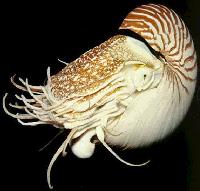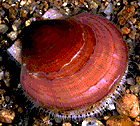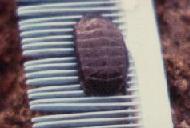Mollusca
Reminder: Clicking on the picture will take you to the site where I originally found it.
Welcome to the mollusk page. The word mollusk means "soft body," and although all these creatures have soft bodies, most aren't left unprotected. Let's see what makes up mollusks.
Generally speaking, a mollusk has three regions to its body. It has a head region where the brain and senses are housed, the body where the organs are kept, and the foot, which is used for motion.
Many mollusks have a more complex body plan than other marine invertebrates. They have highly developed organ systems and the eyes of the squid rival our own for complexity and precision.
Many mollusks have shells. The gastropods, like the snails, have a single shell which coils. Bivalves, like clams, have two shells which are hinged together. Some cephalopods, like squid, have shells too, but their shells are inside of their bodies. Read more about the more common mollusks.
Cephalopods
 The word "cephalo" means head, and "pod" means foot. The
cephalopods are, by definition, head-foots. You may be more familiar with calling them squid and octopuses. When you picture an octopus, all you really see is a head and feet, so the name isn't much of a stretch.
The word "cephalo" means head, and "pod" means foot. The
cephalopods are, by definition, head-foots. You may be more familiar with calling them squid and octopuses. When you picture an octopus, all you really see is a head and feet, so the name isn't much of a stretch.
With the exception of the nautilus, cephalopods do not have shells. The nautilus has a chambered shell which resembles that of a snail, but its body looks more like that of an octopus. The squid and octopus have developed beaks for eating their prey. The octopus has no shell whatsoever, but the squid has a shell on the inside of its body for strength and support. This is called the pen.
Some cephalopods are able to change both their color and shape. When an octopus wants to, it can become camoflauged in coral or rocks on the ocean floor. Some expell ink when threatened.
 Both the octopus and squid are familiar to us. They are easy to tell apart, when you count tentacles. Octo means eight, and eight they have. Squid have ten, all totalled. Eight work a lot like octopus arms, but the two longest are used to grab the prey. The cuttlefish are basically in between the octopuses and the squid.
Both the octopus and squid are familiar to us. They are easy to tell apart, when you count tentacles. Octo means eight, and eight they have. Squid have ten, all totalled. Eight work a lot like octopus arms, but the two longest are used to grab the prey. The cuttlefish are basically in between the octopuses and the squid.
The nautilus is a fun cephalopod because of its shell. The nautilus is both a predator and scavenger. It roughly resembles an octopus, but lives securely in its shell. They are good swimmers and quick too.
And, just for your information, the correct plural of octopus is octopuses, but some people continue to use the false-Latin octopi. Don't. If you don't think "octopuses" sounds intelligent enough, go with "octopods." People will know what you're talking about and you'll sound scholarly.
Bivalves
 Bivalves have the characteristic of having two shells which can open and close. The bivalves include clams, oysters, mussels and scallops. All of these look a lot alike. Their anatomy is similar as well.
Bivalves have the characteristic of having two shells which can open and close. The bivalves include clams, oysters, mussels and scallops. All of these look a lot alike. Their anatomy is similar as well.
Bivalves are filter feeders. They have two valves (hence their name), and through one, they bring water into their shells. It is fitting that this is called the in-current valve (or ihnalent). The other valve is called the ex-current valve (or exhalent). I'll let you figure out what it does.
The bivalves glean food from the water where it is processed in its digestive system. Much of a bivalve's body is digestive system. Most of the rest is a muscular organ called the foot. The foot is used to help the bivalve move.
Surrounding the body of the mollusk is a thin layer called the mantle. The mantle protects the body by secreeting the shell. In the oyster, this mantle also secretes the substance which forms pearls.
Gastropods
 Gastropods are the most common of the mollusks, and you may even have a few in your back yard. Snails and slugs seem to be everywhere. They have the characteristics of most bivalves, so they make good examples.
Gastropods are the most common of the mollusks, and you may even have a few in your back yard. Snails and slugs seem to be everywhere. They have the characteristics of most bivalves, so they make good examples.
The name "gastropod" means "stomach-foot."
Characteristic of all mollusks is the muscular foot on which these animals rely for movement. They have a head which contains a radula. This is a hard, rough tongue-like appendage which it uses to scrape food.
There are freshwater, marine and land gastropods. Marine gastropods include the most of the critters which form "sea-shells." Limpets have shells which look like little volcanoes. There are cone-shaped cells, some of which may be poisonous to humans, long twisted shells which look like horns, and the large (and edible) conch and abalone. The variety of shells in this category is astounding.
Land mollusks are snails or slugs. Don't confuse this type of slug with the cellular slime mold slug. This type has a mouth, feelers, foot and a complex body. They are shell-less snails. The slugs and snails are considered pests because of the damage they do to crops.
Other mollusks
 Most of the other classes of mollusks are small and obscure. There are a couple notable mollusks here though. Pictued is a chiton.
Most of the other classes of mollusks are small and obscure. There are a couple notable mollusks here though. Pictued is a chiton.
One class, the Monoplacophora, were thought to be extinct until re-discovered in 1952. They were found in the deep waters of the Pacific.
There are mollusks which are shell-less and which burrow in the ocean floor. Others have flattened shells. Most of the other mollusks are rare.
All the way back to the animal page,
see sponges,
near the cnidarians,
advance to the arthropods,
enquire about the echinoderms,
wade through the worms,
commune with the chordates or
over to the overview.
 The word "cephalo" means head, and "pod" means foot. The
cephalopods are, by definition, head-foots. You may be more familiar with calling them squid and octopuses. When you picture an octopus, all you really see is a head and feet, so the name isn't much of a stretch.
The word "cephalo" means head, and "pod" means foot. The
cephalopods are, by definition, head-foots. You may be more familiar with calling them squid and octopuses. When you picture an octopus, all you really see is a head and feet, so the name isn't much of a stretch.  Both the octopus and squid are familiar to us. They are easy to tell apart, when you count tentacles. Octo means eight, and eight they have. Squid have ten, all totalled. Eight work a lot like octopus arms, but the two longest are used to grab the prey. The cuttlefish are basically in between the octopuses and the squid.
Both the octopus and squid are familiar to us. They are easy to tell apart, when you count tentacles. Octo means eight, and eight they have. Squid have ten, all totalled. Eight work a lot like octopus arms, but the two longest are used to grab the prey. The cuttlefish are basically in between the octopuses and the squid. Bivalves have the characteristic of having two shells which can open and close. The bivalves include clams, oysters, mussels and scallops. All of these look a lot alike. Their anatomy is similar as well.
Bivalves have the characteristic of having two shells which can open and close. The bivalves include clams, oysters, mussels and scallops. All of these look a lot alike. Their anatomy is similar as well. Gastropods are the most common of the mollusks, and you may even have a few in your back yard. Snails and slugs seem to be everywhere. They have the characteristics of most bivalves, so they make good examples.
Gastropods are the most common of the mollusks, and you may even have a few in your back yard. Snails and slugs seem to be everywhere. They have the characteristics of most bivalves, so they make good examples.  Most of the other classes of mollusks are small and obscure. There are a couple notable mollusks here though. Pictued is a chiton.
Most of the other classes of mollusks are small and obscure. There are a couple notable mollusks here though. Pictued is a chiton.